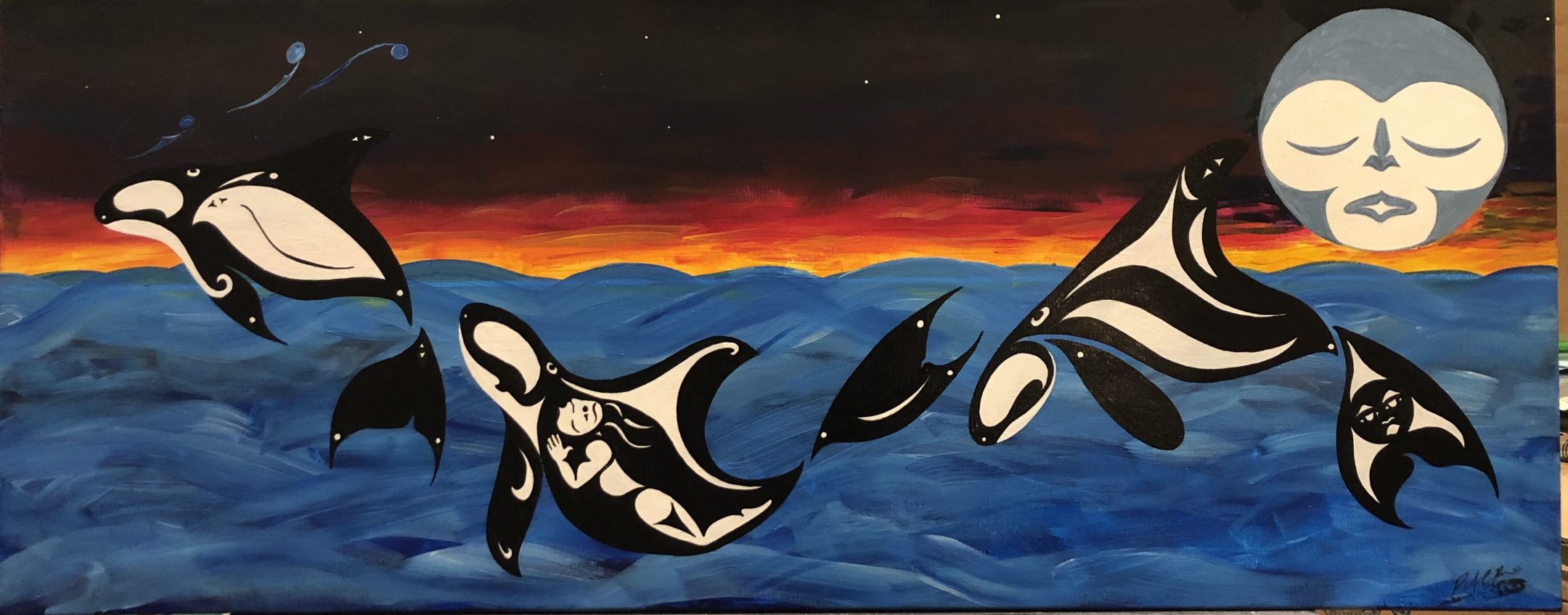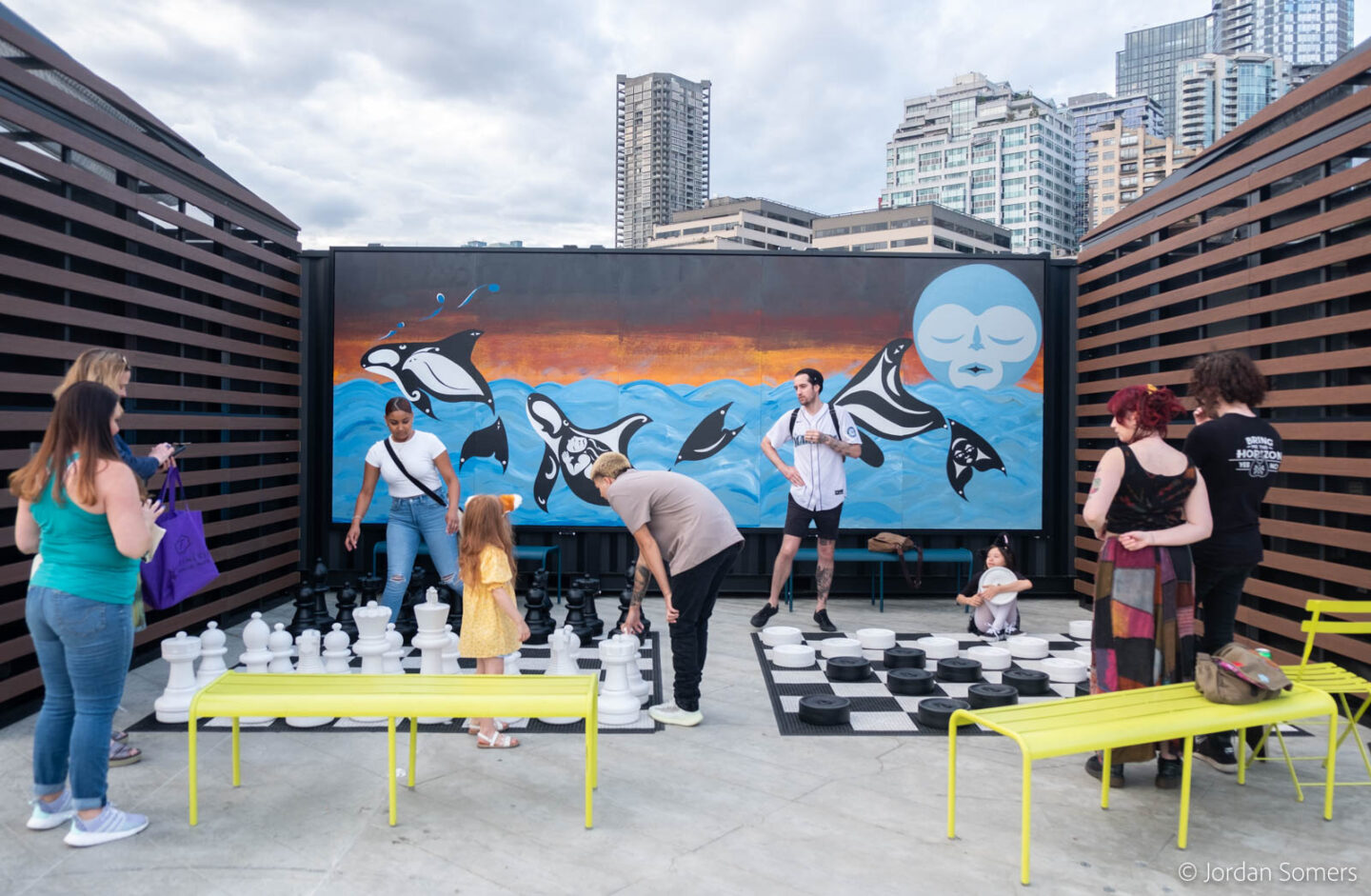"Turbulent Times" Image courtesy of artist Peter Boome.
Turbulent Times Mural
A rough sea with a blue-grey gradient and various colors of blue to white waves. In that sea: a number of orcas. Each orca has different designs within their bodies and dorsal fin. Lightning and thunderclouds in the sky, with a hidden octopus per request by the younger generation. The story behind the image ties into the Salish Sea and the current pandemic: we’re all experiencing turbulent times and we deal with them similarly, but we still are each unique individuals with unique traits.
Mural on display summer 2022 through fall 2023 at Pier 62.
About the Artist: Peter Boome
Peter Boome is a Member of the Upper Skagit Tribe of Washington State. He is well-known for his award-winning Coast Salish art. Peter’s work is found in museums and galleries around the world where his graphic style and carvings are much sought after. Peter has been painting, printing, and carving for decades and works closely with many indigenous artists and communities. Peter received his Master of Environmental Studies from the Evergreen State College and his J.D. from the University of Washington School of Law. In addition to being an artist, Peter also is a practicing attorney and adjunct professor.
An interview with the artist, Peter Boome
How did you first start creating art?
I’ve been creating art since I was a child. I can’t imagine a life without art. You couldn’t leave me alone with markers, or you’d wind up with a mural on the sofa! I was always drawing on the back of furniture or on the wall. Art got me through school. No one else could interpret my notes, because they were mostly drawings. This is the way I look at the world, it’s who I am.
Who are your biggest influences?
I grew up on a reservation. Everyone around me was an artist. As I got older, I started recognizing different styles and narrowing it down. Some of my Coast Salish influences are Stan Greene, Susan Point, Andy Peterson. Joe Geshick (Ojibwa) is also an influence. Rance Hood influenced the way I feel about movement.
What is your favorite medium?
My favorite medium is probably whatever I’m not currently working in. Whatever is most useful for interpreting an idea – that’s the medium I’ll use. I’m starting a new carving soon, and I’m looking forward to it because I haven’t carved in a couple of months. But really, I would rather be painting. Painting is more free. If you don’t like something, just add more paint. I also love printmaking, and I’ve done some glasswork. I like trying different mediums – whatever tells the story best. My favorite part is the planning process.
Where do your ideas come from?
Each piece leads to a new idea. If you pay attention there is inspiration all around. If I’m ever stuck, I read historic accounts or talk with others about tribal stories. Inspiration can come from anywhere and there is no shortage of ideas. There is always something to be explored. From a practical perspective, I’ll also look through my inventory for any gaps – am I low in a specific size, for example. I carry a sketch pad all the time – I always have one around. If I have an idea, I’ll do a quick sketch and make notes in the margins so I can re-visit my plans later on. It’s the equivalent of a journal.
A lot of your work reflects the natural world. What is your relationship with nature and wild places?
I’m a member of the Upper Skagit tribe, a Coast Salish tribe. My art reflects things that occur in my community. My Dad and Father-in-Law were both fishermen. We are place-based people. We are from this place, and my work will reflect that. Even though we live in a built environment I try not to let that color what the world should be. The built environment doesn’t interest me. I’m more interested in a piece that will still resonate 50 years from now. That’s another reason I don’t put lettering in my work. I don’t want a time limit on my work. I want to create something that people will be happy to pass on.
Does the climate crisis influence your work?
Absolutely. I have a degree in environmental science. Seeing where the climate is, it’s disheartening. Fifteen years ago, I created Chasing Shadows, (a piece inspired by dwindling fish populations). My family used to support ourselves by fishing full time. In the course of a short human lifetime this is no longer the case. What does that mean for a cultural perspective for people who have been here for 30,000 years or longer? What does it mean for a society built around the natural environment? I think about how this impacts us from a historic point of view, and how it changes our relationship with the natural world.
I’m very interested in our relationship with the natural world and how we can progress past resource extraction and move on to something else. Instead of having an extractionist attitude to have a more sustainable relationship. It’s easy to make ugly art that is complaining. Ugly protest art is easy. To spark an intellectual conversation is more challenging and that is what I hope to do.
Do you have a favorite animal or plant?
I like alder a lot – it’s very fun to carve. It’s a nice wood when it’s fresh. It’s pretty abundant and it’s a nitrogen-fixing plant, which means it takes nitrogen from the air and brings it into the soil. It’s considered a weed by a lot of folks. It’s fast-growing. I use it in place of cedar because cedar is slow growing. Alder is more sustainable. It’s great for smoking fish and tastes great. It’s very versatile. Birds are some of my favorite animals. I love watching birds. The freedom of birds – their movement and fluidity. They come in such a multitude of shapes and sizes.
In addition to being an artist, you also practice law. How does your art influence other areas of your life, and vice versa?
I am a judge in a drug treatment court. I am also a mediator and work in family court. The creativity of art bleeds into other areas of life. I’m open to creative solutions. I’m not tied to the way things have always been. I’m open to doing what works – whatever that is. If we can work with folks on the drug treatment side, I’m open to it. Let’s try something. The system of punishment becomes a cycle that traps people who are poor or have chemical dependency. If we don’t address the underlying issue, it doesn’t work. Our justice system is not designed to restore a community. I try to look at the bigger impact on people individually and as a community – what can we do that is beneficial? That creativity from the artistic point of view bleeds into this perspective.
How do you find “work life balance” as an artist?
It’s difficult to have a healthy balance and I probably work too much. I’ve owned my own business since 2003 which forces you to be productive. As a result, I cut out a lot of things that people take for granted – like the down time of watching TV, or hanging out with friends, but I’m an introvert, so that works for me. Put me in the woods or on the water – I’m good.
What inspiration did you draw from to create the mural on the waterfront?
When I was asked to create the piece, I learned they were looking for something related to the water. Our resident orcas, the J Pod, they are iconic. They recently lost their matriarch and a new calf. But now there is a newborn, too. I asked myself, what are regular folks going to want to see, and how can I embed imagery within that? That narrowed it down. I wanted to portray the Sound – I wanted a lot of movement. The water was an interesting challenge. How do I create water that is dirty and moving? Let’s talk about how the orcas are swimming in polluted water, but also include the moon to show hope or stability, something that is steady. Humans are at the center because we think we’re at the center, while orcas are just humans in a different form. They live in packs and communicate. They are super intelligent.
What do you hope people remember from your work?
The complexity of it, and how it made them feel. I hope they like it. I hope it inspires some type of emotion.


